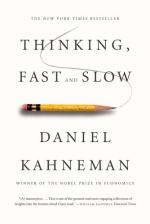|
This section contains 1,073 words (approx. 3 pages at 400 words per page) |

|
Summary
Psychologists have focused on the two modes of thinking. System 1 is automatic and quick thinking. This form of thinking takes little effort. System 2 is effortful thinking that is associated with subjective choice and concentration.
Most people relate to System 2 thinking – the reasoning self that makes choices and decisions. The thinking that makes us feel in control. However, System 1 is the underlying resource for System 2 thinking. System 1 thinking creates complex patterns of ideas. System 2 is slower and constructs those ideas in to an orderly sequence.
Example of System 1 thinking includes, among others: noting which object is farther away; figuring out the source of a sudden sound; answering 2 + 2; reading words on a billboard; understanding simple words; and, completing a common phrase, “bread and….” These are all examples of automatic thinking that takes no effort. Many are impossible not to respond to.
System 2 thinking requires focus...
(read more from the Chapters 1 - 4 Summary)
|
This section contains 1,073 words (approx. 3 pages at 400 words per page) |

|




